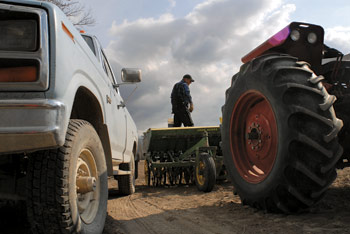There are many factors that go into a successful harvest, but perhaps none as powerful as weather. In the Flathead, it’s been a hot, dry summer, and such a pattern of weather has an interesting effect on crops; some thrive in it, some wilt during it, but all must endure it.
In Creston, Miles Passmore said the heat has quickened the harvest for many of his family’s crops, which include wheat, barley and canola on about 1,400 acres.
They are typically in full-harvest mode the week after the Northwest Montana Fair, Passmore said, but this year they were done three or four days before the fair even began.
“We just had a much hotter summer,” Passmore said.
It’s not necessarily a bad thing, he said, depending on the crop. Dry heat is good for cutting the crops, because there’s little-to-no risk for rain dampening their work.
Canola, on the other hand, does not appreciate the intense heat early in the summer. High heat can hurt the plant when it is in its flowering stage, and Passmore said his family saw this effect in full swing in their canola fields in July.
Other weather phenomena, such as hail, can also have deleterious effects on crops. In Gallatin County, hail and wind in August caused such damage that the county was designated a natural disaster, and the total damage is estimated at about $50 million.
The Flathead hasn’t been immune to random storms either.
“One big hailstorm hit us pretty hard on about 400 acres,” Passmore said.
Andy Lybeck, the agronomy division manager at CHS Kalispell, said the heat from the beginning of July onward “really hurt the spring crops,” estimating they took a 10 to 15 percent hit. Hail was also an issue.
“We did see more hail damage this year than we have in the past five or 10 years that I’m familiar with, but certainly nothing like Gallatin County.”
This summer has also shown new types of pestilence and disease for crops.
“We did have the first case that I’ve ever seen of Verticillium Wilt in alfalfa,” Lybeck said.
Verticillium Wilt is a fungus-caused disease that causes leaflets to wilt during periods of slight water deficit, according to the Ohio State University Extension, and eventually causes the plants to die, thus reducing the yield of an infected stand.
This summer is also the first season for armyworms in canola, Lybeck said. These little bugs look like caterpillars, and hatch from the ground and destroy the crop.
“It’s a pest we haven’t seen before,” he said. “It’s a devastating one.”
 |
|
Mark Siderius carries a bucket of fertilizer from his truck across the back of a grain drill. The drill plants the pea seeds and fertilizes the ground at the same time. – Lido Vizzutti | Flathead Beacon |
Still, despite weather and pests, Northwest Montana looks to pull at least an average harvest this year.
Pat McGlynn, Flathead County’s Montana State University agricultural extension agent, said the hay harvest really benefitted from the warm, dry weather, so much so that farmers with irrigation in place were able to get a second cutting.
It’s high-quality product, and it’s been in high demand as well.
“People have been coming here from long distances to get our hay,” McGlynn said.
The cherry harvest was fast and furious, with early frost damage in the spring quickly overcome by a bust crop in Washington, meaning high demand for Flathead fruit.
The dry heat has also warded off grasshoppers, which just a few years ago were proving troublesome in the valley, McGlynn said. The only insects she’s seen that have been trouble this summer have been wasps and yellowjackets, which have been attracted to fruit trees.
Otherwise, McGlynn said the reports she’s received from farmers indicate more positives than negatives for this year’s harvest.
“I’d say for our area, agriculture is looking pretty good,” she said.
Lybeck said with all factors considered – and the verdict still out on the quality of the second cutting of hay – this year’s harvest is looking to be average, which is good news for farmers.
And in Creston, Passmore said that despite the hail the short flowering for his canola, the summer has yielded a solid bounty for his family’s farm.
“It’s been a good harvest,” he said.